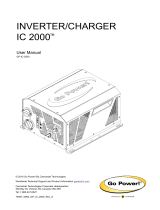
13
EN NL Appendix
UPS feature
If this setting is ‘on’ and AC on the input fails, the MultiPlus switches to inverter operation practically without interruption. The MultiPlus
can therefore be used as an Uninterruptible Power Supply (UPS) for sensitive equipment such as computers or communication
systems.
The output voltage of some small generator sets is too unstable and distorted for using this setting – the MultiPlus would continually
switch to inverter operation. For this reason, the setting can be turned off. The MultiPlus will then respond less quickly to AC input
voltage deviations. The switchover time to inverter operation is consequently slightly longer, but most equipment (most computers,
clocks or household equipment) is not adversely impacted.
Recommendation: Turn the UPS feature off if the MultiPlus fails to synchronise, or continually switches back to inverter operation.
Dynamic current limiter
Intended for generators, the AC voltage being generated by means of a static inverter (so-called ‘inverter’ generators). In these
generators, rpm is down-controlled if the load is low: this reduces noise, fuel consumption and pollution. A disadvantage is that the
output voltage will drop severely or even completely fail in the event of a sudden load increase. More load can only be supplied after the
engine is up to speed.
If this setting is ‘on’, the MultiPlus will start supplying extra power at a low generator output level and gradually allow the generator to
supply more, until the set current limit is reached. This allows the generator engine to get up to speed.
This setting is also often used for ‘classical’ generators that respond slowly to sudden load variation.
WeakAC
Strong distortion of the input voltage can result in the charger hardly operating or not operating at all. If WeakAC is set, the charger will
also accept a strongly distorted voltage, at the cost of greater distortion of the input current.
Recommendation: Turn WeakAC on if the charger is hardly charging or not charging at all (which is quite rare!). Also turn on the
dynamic current limiter simultaneously, and reduce the maximum charging current to prevent overloading the generator if necessary.
Not adjustable with DIP switches.
BoostFactor
Change this setting only after consulting with Victron Energy or with an engineer trained by Victron Energy!
Not adjustable with DIP switches.
Programmable relay
By default, the programmable relay is set as an alarm relay, i.e. the relay will de-energise in the event of an alarm or a pre-alarm
(inverter almost too hot, ripple on the input almost too high, battery voltage almost too low). Not adjustable with DIP switches.
Auxiliary AC output (AC-out-2)
Besides the uninterruptable output, a second output (AC-out-2) is available that disconnects its load in the event of battery operation.
Example: an electric boiler or air conditioner that is allowed to operate only if the genset is running or shore power is available.
In case of battery operation, AC-out-2 is switched off immediately. After the AC supply has become available, AC-out-2 is reconnected
with a delay of 2 minutes, this to allow a genset to stabilise prior to connecting a heavy load.
VirtualSwitch
The VirtualSwitch is a software function in the MultiPlus microprocessor. The inputs of this function are parameters that can be selected
with VEConfigure (e.g. certain alarms or voltage levels). The output is binary (0 or 1). The output can be connected to a binary
microprocessor output (e.g. the multi-functional relay, or the relay in one of the AC inputs).
If connected to the multi-functional relay, and with battery voltage and time as input values, for example, the VirtualSwitch can be
configured to supply a generator starting signal.
If connected to an AC input relay, and with battery voltage and time as input, for example, the connected mains supply can be
interrupted.
Application: A house or an office connected to the public mains, fitted with solar panels with energy storage in batteries.
The batteries are used to prevent return delivery to the mains. During the day, redundant solar energy is stored in
batteries. This energy is used in the evenings and at night. An energy shortfall is compensated by the mains. The Multi
converts the battery DC voltage to AC. The power is always less than or equal to the power consumption, so that return
delivery to the mains does not occur. In the event of mains failure, the Multi isolates the premises from the mains, which
become autonomous (self-sufficient). In this way, a solar energy installation or a combined micro-scale heating and
power plant can be economically used in areas with an unreliable mains supply and/or financially unfavourable energy-
return conditions.






















